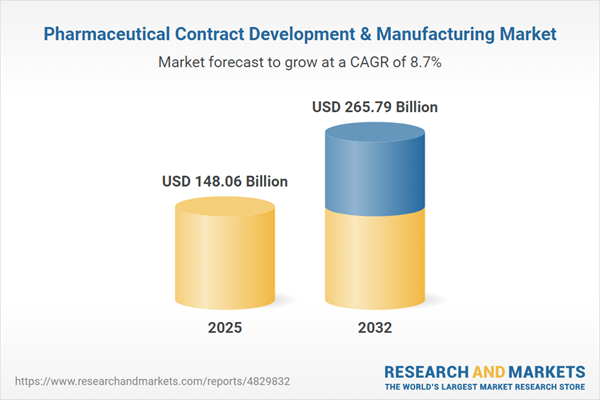Speak directly to the analyst to clarify any post sales queries you may have.
The pharmaceutical contract development and manufacturing market is evolving rapidly, driven by increased demand for agile, specialized solutions that streamline drug development and manufacturing for sponsors worldwide.
Market Snapshot: Pharmaceutical Contract Development and Manufacturing
In 2024, the pharmaceutical contract development and manufacturing market was valued at USD 136.27 billion, progressing to USD 148.06 billion in 2025. With an expected CAGR of 8.70%, the market is forecast to surpass USD 265.79 billion by 2032. Stakeholders across the sector are reshaping partnership models, operations, and technology adoption to capture emerging opportunities.
Scope & Segmentation: Comprehensive Coverage for Strategic Clarity
- Service Type: Contract development and manufacturing services, including analytical development, clinical trial material manufacturing, drug formulation development, process development, API manufacturing, finished dosage form manufacturing, and packaging services.
- Development Stage: Preclinical, clinical (Phase I, Phase II, Phase III), and commercial project delivery, each with distinct process and compliance requirements.
- End Use: Therapeutic areas addressed include cardiovascular, central nervous system, infectious diseases, and oncology markets.
- Customer Type: Service providers cater to biosimilar manufacturers, biotechnology companies, generic pharmaceutical firms, and innovator pharmaceutical organizations.
- Geographical Regions:
- Americas: North America (United States, Canada, Mexico), Latin America (Brazil, Argentina, Chile, Colombia, Peru).
- Europe, Middle East & Africa: Europe (United Kingdom, Germany, France, Russia, Italy, Spain, Netherlands, Sweden, Poland, Switzerland); Middle East (United Arab Emirates, Saudi Arabia, Qatar, Turkey, Israel); Africa (South Africa, Nigeria, Egypt, Kenya).
- Asia-Pacific: China, India, Japan, Australia, South Korea, Indonesia, Thailand, Malaysia, Singapore, Taiwan.
- Key Companies Covered: Thermo Fisher Scientific Inc., Lonza Group AG, Catalent Inc., Recipharm AB, Samsung Biologics Co., Ltd., WuXi AppTec Co., Ltd., Boehringer Ingelheim International GmbH, AGC Biologics Inc., Siegfried Holding AG, Fareva Holding SAS.
- Technology & Trends: Adoption of continuous manufacturing, single-use technologies, modular facilities, digitization, integrated analytical solutions, and sustainability enhancements.
Key Takeaways: Strategic Insights for Senior Decision-Makers
- Strategic partnerships between service providers and technology firms are accelerating the adoption of advanced platforms and digital process controls across projects.
- Contract model evolution is fostering more flexible and risk-sharing arrangements, appealing to both emerging biotechnology firms and established pharmaceutical players.
- Quality assurance is increasingly driven by real-time data, analytics, and predictive maintenance, supporting greater operational resilience and faster regulatory approval pathways.
- Regional expansion in Asia-Pacific and Latin America provides sponsors with new cost-competitive options, while the Americas and Europe maintain strengths in integrated and high-value capabilities.
- Therapeutic focus diversifies service requirements: oncology and infectious disease projects demand sophisticated manufacturing, while cardiovascular and central nervous system work leans on established methods.
- Operational flexibility, multi-purpose facilities, and sustainable manufacturing are emerging as key differentiators among contract development and manufacturing organizations.
Tariff Impact: US Tariff Measures Shaping Global Supply Chains
United States tariffs imposed in 2025 on select chemicals and pharmaceutical inputs are prompting organizations to review suppliers and adjust global sourcing strategies. To maintain project viability, many service providers are relocating manufacturing activities closer to end markets, emphasizing local procurement and diversified supplier networks. Cross-border planning now regularly incorporates dynamic cost analyses and scenario modeling, helping sponsors manage ongoing trade volatility and protect margins.
Methodology & Data Sources
This report leverages a robust research methodology, including primary interviews with executive decision-makers and comprehensive secondary research across industry publications, regulatory filings, and patent data. Subject-matter experts validated all key findings and insights through independent review.
Pharmaceutical Contract Development and Manufacturing: Why This Report Matters
- Gain an in-depth understanding of market dynamics and competitive positioning to inform strategic planning and partnership selection.
- Identify the impact of regulatory, technological, and geo-economic shifts on sourcing, process development, and contract manufacturing practices.
- Access actionable, segment-specific intelligence supporting agile decision-making amid industry transformation.
Conclusion
This analysis delivers essential insights for navigating the complex, rapidly evolving pharmaceutical contract development and manufacturing landscape. Strategic adaptation and investment in technology, partnerships, and operational agility are set to define long-term leadership.
Additional Product Information:
- Purchase of this report includes 1 year online access with quarterly updates.
- This report can be updated on request. Please contact our Customer Experience team using the Ask a Question widget on our website.
Table of Contents
3. Executive Summary
4. Market Overview
7. Cumulative Impact of Artificial Intelligence 2025
Companies Mentioned
The companies profiled in this Pharmaceutical Contract Development & Manufacturing market report include:- Thermo Fisher Scientific Inc.
- Lonza Group AG
- Catalent Inc.
- Recipharm AB
- Samsung Biologics Co., Ltd.
- WuXi AppTec Co., Ltd.
- Boehringer Ingelheim International GmbH
- AGC Biologics Inc.
- Siegfried Holding AG
- Fareva Holding SAS
Table Information
| Report Attribute | Details |
|---|---|
| No. of Pages | 193 |
| Published | October 2025 |
| Forecast Period | 2025 - 2032 |
| Estimated Market Value ( USD | $ 148.06 Billion |
| Forecasted Market Value ( USD | $ 265.79 Billion |
| Compound Annual Growth Rate | 8.7% |
| Regions Covered | Global |
| No. of Companies Mentioned | 10 |









